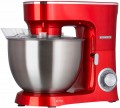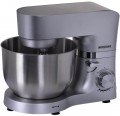Accessories
—
The whisk . As the name implies, this attachment is designed for whipping and mixing "light" liquids (batter, mayonnaise, eggs, etc.). Most often the whisk is similar to that used in mixers (although there are other options). Sometimes there may be two such whisks.
—
The hook for kneading dough. The attachment for kneading thick dough. It has a special shape, due to which the dough is evenly mixed, and there are no unused ingredients on the walls of the bowl.
—
The double hook for kneading. The double hook allows you to significantly increase the efficiency of kneading thick dough. The second hook is used so that the dough does not stick to the bowl and mixes more thoroughly. Depending on the model, the double hook can be realized as a one hook or as a pieces of hook (two single kneading hooks) that can be used independently of each other.
—
The spatula for mixing (bitter). The spatula for mixing is used in the making of light dough, confectionery mixtures, all kinds of pastas. Bitter can also simply mix various ingredients. It can be made of metal or plastic, as well as with additional rubber seal to prevent the product from sticking in the bowl.
—
Silicone beater. An attachment for mixing and whipping delicate ingredients (creams, dough, light "airy" mixtures, etc.)
.... This type of beater is made of silicone, which ensures gentle and effective contact with the surface of the food processor bowl. A silicone beater is intended for use when it is important not to damage the structure of the ingredients. Additionally, silicone does not absorb odors and is easy to clean from any contaminants (including under running tap water).
— The disk for minced meat. Traditional grate grinder. The minced meat disk can have a different mesh size, from 3 to 8 mm, which has a direct impact on the consistency of the cooked minced meat. Usually, three discs are included in the standard meat grinder set: for a fine fraction (cells are about 3 mm), for a medium fraction (about 5 mm) and for a large fraction (about 8 mm). Less commonly on the market there are also discs with smaller cells (1 mm or less), such are used for making pate.
— The attachment for kibbeh. Kibbeh is a dish of Arabic cuisine, which is a hollow sausage made of minced meat, which is stuffed with lumpy meat, vegetables and other products. After that, kibbeh are fried like meatballs or baked in the oven. The kibbeh attachment is fixed on the spout of the meat grinder, instead of the clamping ring for the grate, and allows you to quickly and easily form hollow sausages from minced meat.
— The attachment for homemade sausages. It is a thin-walled tube with a diameter of up to 20-30 mm and a length of 50 to 100 mm. The attachment is installed on the “spout” of the meat grinder, instead of the clamping ring for the mince/pate grate, and the edge of the membrane of the future sausage is put on the second end of the product. Thus, the attachment allows you to form homemade sausages, which are later fried or baked in the oven.
— For tomatoes/soft vegetables. The auger attachment for processing tomatoes and other soft vegetables or fruits, which effectively separates flesh from peel and tails. This is for making tomato juice or compotes at home.
— For pasta (macaroni). Wide popularity gained discs for making macaroni with openings of different calibres for certain types of pasta (tagliatelle, fettuccini, spaghetti and etc.).
— For cookies. The cooking attachment for cookies and pastry. It is a disc attachment with fixed plate with openings-patterns for forming curly dough. It is recommended to use low and medium speeds of the food processor for making the cookies.
— The chopper knife. The model is equipped with a knife for a food processor, which allows you to cut salads, shred cabbage and do a number of other operations.
— Disc for shredding/slicing. A disc with special slots that play the role of knives during rotation. Allows you to quickly and evenly cut fruits and vegetables into slices, especially useful for cutting large quantities of food.
— For dicing. The attachment for cutting fruits and vegetables in the form of small cubes. Great for cooking salads.
— The French fries disc. To make French fries, potatoes need to be cut in a special way — long thin sticks. The special disk, which is equipped with some food processors is for such cutting.
— For draniki (potato pancakes). Draniki, or potato pancakes, are pancakes that are made from mashed potatoes. The attachment for their cooking is usually a kind of "prickly" grater, which allows you to bring raw potatoes to the desired consistency. It can also be used for other purposes (for example, making applesauce).
— The disc for making sauces. A specialized attachment that allows you to grind semi-finished products into puree and making thick unigorm mixtures, such as sauces, creams, etc. It is a disk with special guides on the surface.Bowl capacity
The volume of the food bowl provided in the food processor. Most often the full volume is indicated, not the working volume. It should be noted that you can not use the bowl completely when cooking, the working volume is approximately 70% of the total. Thus, about 4 liters can be used in a 6 liter bowl. And if you go into the recipes and power modes of the food processor (see the instructions), then smaller numbers are acceptable for preparing a particular dish (kneading dough, mixing salad, etc.).
Note that a large capacity affects the dimensions and weight of the unit, and also requires a more powerful engine — which affects energy consumption and price. So when choosing a bowl by capacity, you should not chase the maximum capacity, but take into account the planned volumes of work.
Power
Rated power of the food processor. Most of this power comes from the engine — the rest of the unit consumes very little energy. Usually, the
more power, the higher the productivity of the unit, and the less time it takes to process products.
Note that the optimal power value directly depends on the volume of the bowl (see the relevant paragraph): for example, for a 1.5 kg bowl, at least 300 W is desirable, for a two-kilogram bowl — 400 W, a three-kilogram bowl — at least 700 W. And with the same bowl capacity, a more powerful unit will be more productive, it will work faster and better cope with high loads (for example, a full load). On the other hand, an increase in power affects energy consumption and price.
Number of speeds
The number of fixed speeds of rotation of the attachments provided in the design of the food processor. The more of them, the more accurately you can choose the required speed for each specific mode of operation. It is worth noting that some devices do not have fixed speeds — the control is carried out smoothly (see Stepless speed controller)
Main bowl material
The bowls of modern food processors can be made of plastic, glass, or metal.
The plastic bowls are the most common due to their low cost and durability. They are lightweight, resistant to falls and can withstand quite large loads, they can be both transparent and opaque. The disadvantage of plastic is an increased tendency to scratches.
The glass bowls are scratch-resistant, and they allow you to monitor the products processing through transparency. However, the glass is a fragile material, and such bowls are very sensitive to falls, shaking, and bumps.
Metal (usually stainless steel) is the strongest and most durable material. However, it is opaque, in addition, the
metal bowl usually significantly affects the cost of the device.
Body material
The main material used for the body of the unit.
—
Plastic. The main advantage of plastic is the relatively low cost. In addition, this material can have almost any colour, including quite bright ones. In terms of strength and reliability, the plastic is inferior to metal, but this difference does not play a special role in normal use, it becomes noticeable only in various emergency situations (during falls, overheating, etc.). Also, plastic bodies are relatively easy to scratch, but this point mainly affects the appearance of the unit and does not affect the functionality. In light of all this, only plastic is the most popular material for the bodies of modern food processors.
—
Metal. Metal bodies are distinguished by their solid appearance and high strength. On the other hand, this material is noticeably more expensive than plastic, and therefore is less common — mainly in middle and high class food processors.

